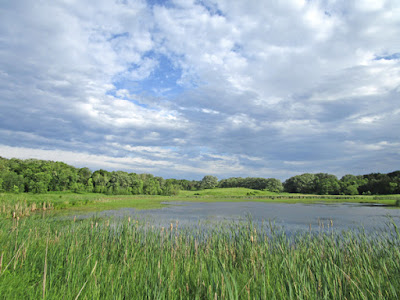Bassett Creek meanders for roughly twelve miles from Medicine Lake, in the suburb of Plymouth, through mostly residential sections of Crystal and Golden Valley, before entering Minneapolis, where it trickles through Theodore Wirth Park and along the edge of the Bryn Mar neighborhood, through a wooded valley past the derelict Glenwood Springs Water Company and Utepil's Brewery and Tap Room.
For the last two miles it ceases to be a creek, the flow being carried by an underground tunnel that enters into the Mississippi River downstream from the St. Anthony Locks. Evidently the large tunnel you see issuing into the Mississippi just south of Plymouth Avenue, which I had always presumed was the mouth of Bassett Creek, is no longer connected to it. I discovered my error just the other day while reading a profile of Bassett Creek in the Mill City Times .
 |
| Inglewood Spring on Bassett Creek (1894) |
The historical information in the article was interesting and the vintage photos were fascinating, but I couldn't help noticing that the data was out-of-date and the conclusion wildly inaccurate. The author, Michael Rainville, Jr., writes: "The story of Bassett’s Creek should be seen as an example of how destructive and disruptive humans can be to nature. We are fortunate to not have many stories with sad endings."
Rainville doesn't seem to be aware that the Bassett Creek Water Management Commission has been cleaning up the creek for half a century and more.
 |
| One of three lagoons in Wirth Park on Bassett Creek |
I happen to live not far from the creek, and I've watched them move boulders, lay underground tunnels, install long rolls of straw with willow saplings embedding in them along the banks, and in other ways improve the integrity of the creek bed and cut down on erosion.
A look at the commission's website reveals that at the moment there are twenty-five capital improvement projects in the works within the Bassett Creek Watershed. One that excites me in particular is a proposal to dredge the sediment that has accumulated in the lagoons along the creek in Theodore Wirth Park between Golden Valley Road and Trunk Highway 55. I was not aware until I read the proposal that the lagoons were created in the mid-1930s by CCC crews; I presume they used shovels.
A recent study found that large amounts of sediment didn't start to accumulate until the early 1990s. I wonder why? Nowadays what used to be a lovely body of water is usually a big mudflat, often covered with weeds, though further upstream, in what I like to call the Bassett Creek Gorge, a gurgling brook rushes down across the stones at all times of the year.
I've been measuring the water quality of the creek for the DNR for seven or eight years now as part of their Citizen Stream Monitoring Program. This is not a big deal. I drive down maybe twenty times during the summer, throw my yellow plastic bucket over the railing of the stone bridge—also probably the work of the CCC—and jiggle the rope until the bucket starts taking in water. Then I haul up the bucket and pour the water into a long, clear plastic tube, which allows me to determine how dirty or clean the water is.
It was only this summer, after years spent hoisting several gallons of water, time and again, up from the creek, that I discovered, by chance, what should have occurred to me all along: I do not need a full bucket of water to fill the tube. Two inches in the bottom of the bucket will be plenty.
Though passers-by seldom take an interest in what I'm doing, I occasionally meet someone interesting at the bridge. One early morning, with the dew still on the grass, it was a man photographing dragon-flies. One sultry evening it was a man who'd moved here from India with his wife. He was pondering the meaning of the word "chitta."
"What is chitta?" I asked. "Is it like "chi"?
"No, it's a division of the mind. Hard to explain."
Hilary was with me that evening, and the three of us got in to a lively discussion of "chitta," consciousness, perception, and other concepts. I don't recall that we arrived at any conclusions, but I do remember how golden the light was that evening.
Just the other day I was taking a reading when a group of school kids came by. "What are you doing?" one of them asked. So I told her. Then I pointed out the big carp that was moving slowly upstream. That got them excited. The counselors finally arrived and one of them said, "Oh, you've got a turbidity tube. I used one of those in environmental class." She didn't sound too excited about it.
Then she said, "Come on, kids."
As they were leaving one little girl said, "That looks like a koi to me."
"Same thing," I said. "It's the same fish .... though koi are prettier."
 |
| The view from the bridge |

































